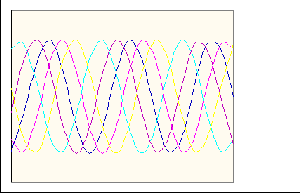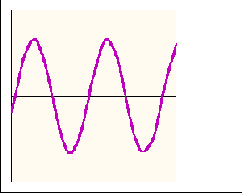Lasers
What are lasers?
Laser stands for Light Amplification by the Stimulated
Emission
of Radiation. In order to understand what a laser is, you
first need to understand how normal light is produced.
Light is made when an electron within an atom is 'excited', and then
quickly drops back into its original state. This can be thought of
as the electron being pushed out of the groove it normally travels in,
and then dropping back in. Energy must be put in to cause the electron
to leave its groove, and when the electron falls back into its groove,
the energy is released, in the form of light.
Most people know that light comes in waves. In normal light,
because the electrons are all popping in and out of their grooves at different
times, these waves are out of phase. This means that the tops of
the waves all come at different times, so they cannot reinforce each other.
In a laser, the light has been manipulated so that all the waves are in
phase, and all their tops come at the same time. It looks like this:
| Normal light |
 |
| Laser light |
 |
You can see how the waves come in unison in a laser, reinforcing each other.
This makes the laser much more powerful. A laser can be pictured
like a wave at a beach, that you can surf on, where as light is just like
choppy water.
Back to the top of this page
Advantages and
disadvantages of lasers as weapons
Lasers are used as weapons in Eon during the battle between the Soviets
and the Americans over possession of the Stone. The laser guns used
are hand held, anti-personnel weapons, as opposed to large lasers designed
to interfere with the enemy's equipment.
The use of laser guns in science fiction is certainly not a new idea,
in fact they have become rather cliché. This doesn't prevent
them from being a viable alternative to projectiles in the future, particularly
in a near vacuum environment. Lasers have several advantages in a
vacuum:
-
although the power of lasers dissipates in an atmosphere, in a vacuum a
laser's range would be massive.
-
the extreme speed of a laser prevents any of the interception or evasion
that could occur with projectiles over large distances.
-
a laser's aim is not noticeably effected by gravity.
-
in vacuum, you need only burn through a thin space suit to kill an enemy,
and lasers are good at this
On the other hand, the lasers produced today have features that would make
them impractical for combat. Current lasers are too bulky, and require
too much power input for not enough power output. Lasers used for
cutting and welding are about the size of a workbench, and only output
about 70 joules per pulse (Electrox
- Lasers for cutting, welding and marking), so obviously these lasers
could not be used in combat.
This does not mean that we have to wait for lasers and their powers
sources to become much more efficient before they can play an offensive
role in military operations. One thing lasers are very good at is
disrupting electrical equipment. Already high power lasers fired
into space have to be careful not to damage any communications satellites.
It would be fairly simple to create a laser for intentionally damaging
satellites, or other delicate equipment.
Back to the top of this page
Alternatives to simple lasers
A new weapon being developed in the U.S.A. is the phaser. This
weapon uses a laser to ionize a path of air, and then sends an electrical
charge down the path. The advantage of this device is that it's power
can be adjusted to temporarily paralyze, stun, knock out or kill a target.
I cannot, however, be used in a vacuum, as it requires an ionized path
of air to work, and it also suffers from the size and power constraints
of regular lasers.
Projectiles are alternatives in vacuum. Possibilities for these
include:
-
a spring system
-
a pneumatic system
-
a combustion system
-
rail guns
Spring systems would not be very practical in space, because any
spring able to fire a projectile at useful velocities would be too bulky,
and too hard to cock.
A pnumatic pump would consume far too much gas to be viable for space
combat, and even if it didn't, air guns simply aren't very strong.
Modern guns use a combustion system that would work well in space.
Gunpowder provides its own oxidising agent, so an atmosphere is not required.
Combustion powered guns may even work better in a vacuum, because a greater
pressure difference on either side of the bullet would make it accelerate
at a greater rate.
A rail gun is another good option. Rail guns use magnetic propulsion
to accelerate an object along a rail. The object continues to accelerate
until it reaches the end of the rail, and is flung at an unsuspecting victim.
Rail guns have been proposed as a launch method off a lunar base, because
they work well in vacuum, and consume any fuel. If you would like
to see a similar device in action, take a look at the "Jumping Ring" exhibit
at Questacon:
The National Science an Technology Center, in Canberra Australia.
They probably have an exhibit like it at your local science center, if
you don't have the pleasure of living near our lovely city.
Back to the top of this page
Current laser applications
Lasers have a huge range of uses in modern industry. Some lasers
that are quite likely to be used in conjunction with you and I are those
used by the police to determine the speed of passing vehicles. If
you wish to visit a site related to this, a site that I don't approve of
at all, click here.
Lasers are used to read and write CDs. In espionage, windows
are 'read' in the same way. Lasers reflected off windows measure
vibrations in the glass in order to hear what is going on inside.
Another application of lasers that you may have encountered is laser
pointers. It is rare for these to be used for their intended purpose:
pointing at things during presentations. More often they can be found
in school yards, being used to damage retinas and generally irritate people.
Industrial lasers are used to do detailed etching, cutting and welding,
and Lasers are also used to communicate with satellites.
At the forefront of laser technology, lasers are being used to trap
individual atoms. These atoms an then be turned into 'atom lasers'.
Back to the top of this page
Back to The Science of Eon subject
menu
Back to the Capital Dreaming
Home page
Email Me at micah_j@hotmail.com



